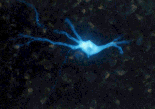

|
||||
| Sponsored by Wake Forest University School of Medicine and National Families in Action | ||||
Medications Development Newly Discovered Receptor May Be Important In the Development of Anti-psychostimulant Medications |
||||
Scientists at the Oregon Health and Science University have discovered and characterized a receptor for trace amines that may be instrumental in developing new antipsycho- stimulant medications. The investigators characterized a G-protein-coupled receptor called trace amine receptor(TAR) which stimulates the production of cAMP when exposed to the trace amines tyramine,tryptamine, octopamine, and para-tyramine. This latter substance is structurally and functionally related to amphetamines. Although TAR is found in humans, the scientists used rats to demonstrate that beta-PEA for beta-phenylethylamine, a substituted amphetamine that represents a class of hallucinogens that include mescaline, MDMA (known on the street as |
“ecstasy”), and MDA, is the substance that most increased the receptivity of TAR. This finding suggests that the effects of amphetamines may be mediated in part by the TAR receptor.
A research team headed by Dr. David K. Grandy and including James R. Bunzow, and Drs. Susan Amara and Mark Sonders published the study in the December 2001 issue of Molecular Pharmacology. NIDA NewsScan, Janury 3, 2002 |
|||
| Antipsychotic Drug Risperidone Reduces Euphoric Effects of Cocaine |
||||
| Repeated dosing with risperidone, an antipsychotic drug used to treat disorganized or psychotic thinking, was effective in blunting the euphoric highs associated with cocaine use in nine human volunteers. The subjects treated with low doses of risperidone for 5 days prior to receiving intravenous (IV) cocaine reported perceiving less of a high than they did from the same amount of IV cocaine received prior to the risperidone pretreatment. The scientists from the UCLA School ofMedicine who conducted the study say that risperidone reduced the high a significant but modest degree, about 15 percent. Previous studies using a single dose of dopamine antagonists failed to reduce the perceived effects of cocaine. The UCLA scientists concluded that repeated dosing, rather than a single treatment, may be necessary. Medications such as risperidone |
block specific dopamine and serotonin receptors, elements of the brain circuitry that are thought to play a role in the perception of pleasure and in craving.
Lead investigator Dr. Thomas F. Newton published the study in issue 102:3 of Psychiatry Research. NIDA NewsScan, January 30, 2002 |
|||
|
Researchers Investigate Potential New Treatment for Drug Abuse Relapse Related To Environmental Cues |
||||
For individuals trying to break free of drug addiction, exposure to environments previously associated with drug use is one of the most common factors triggering relapse to drug-using behavior. Researchers from the Brookhaven National Laboratory, the NIDA Intramural Research Program, and other institutions collaborated on a study to better understand the neurochemical mechanisms controlling this phenomenon. The scientists trained rats to associate cocaine administration with a certain environment. On the test day, rats were exposed to cocaine-associated environmental cues, but no cocaine was available.Dopamine concentrations in certain regions of the brain increased by 25 percent when the rats were placed in the environment they associated with cocaine. However, when racemic vigabatrin, a drug used to prevent seizure disorders in children, was given to the rats 2 |
and one-half hours before they were placed in the cocaine-associated environment, there was no increase in their dopamine levels.
This
study was published by lead investigator Dr. Madina Gerasimov in the
March 2001 issue of the European Journal of Pharmacology. It
is available online at the journal Web site NIDA NewsScan, July 24, 2001 |
|||
| Home | For Journalists | For the States | Science Update | Links | Glossary | About |
Last Revision
info@addictionstudies.org